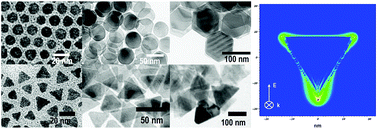Copper sulfide nanosheets with shape-tunable plasmonic properties in the NIR region†
Abstract
2D copper sulfide nanocrystals are promising building blocks of plasmonic materials in the near-infrared (NIR) spectral region. We demonstrate precise shape and size control (hexagonal/triangle) of colloidal plasmonic copper sulfide (covellite) nano-prisms simply by tuning the precursor concentration without the introduction of additional ligands. The ultra-thin 2D nanocrystals possess sizes between 13 and 100 nm and triangular or hexangular shapes. We also demonstrate CuS nanosheets (NSs) with lateral sizes up to 2 microns using a syringe pump. Based on the experimental findings and DFT simulations, we propose a qualitative and quantitative mechanism for the formation of different shapes. The analysis of the spectral features in the NIR region of the synthesized CuS nanocrystals has been performed with respect to the shape and the size of particles by the discrete dipole approximation method and the Drude–Sommerfeld theory.



 Please wait while we load your content...
Please wait while we load your content...